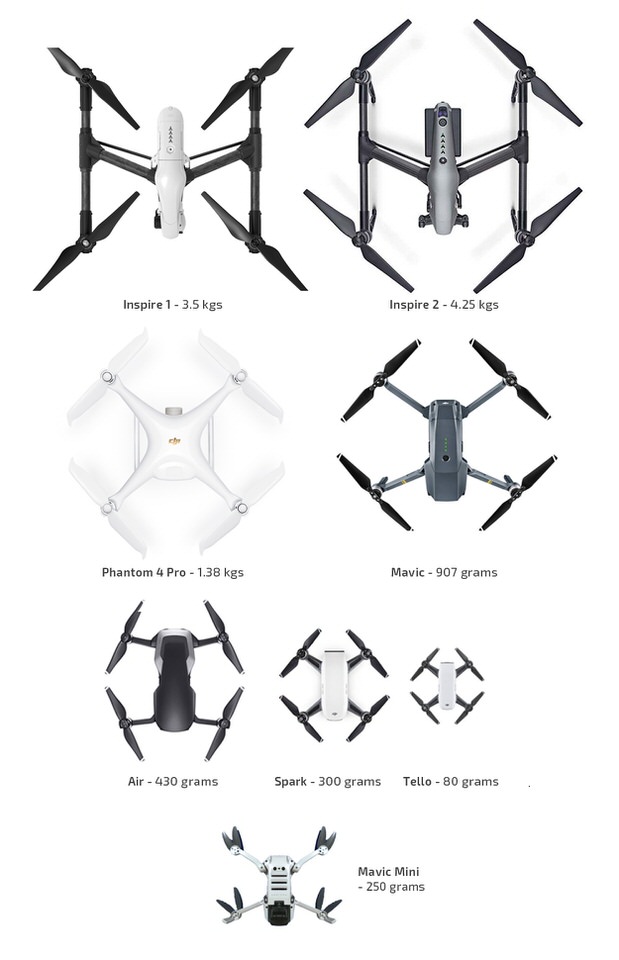DJI made a huge splash when they launched their latest drone, the DJI Mavic Mini back in November 2019. Priced at $399, its biggest selling point is its palm-sized dimensions.
The Mavic Mini is certainly an engineering marvel and is touted as a good option for weekend flyers who are looking to capture some memorable family moments. But is the Mavic Mini a good option for Part 107 commercial pilots? And, how does the DJI Mavic Mini compare to their other entry-level product, DJI Spark? And should you rather buy the more capable but expensive, DJI Mavic Air?
So, let’s take it from the top.
Build
The biggest USP of the DJI Mavic Mini is its portability and its 249 grams weight. Both the Mavic Air (430 grams) and the DJI Spark (300 grams) weigh more than the DJI Mavic Mini. And while the Mavic Mini and Mavic Air are portable, the DJI Spark is not. No bigger than a large smartphone, the DJI Mavic Mini can easily fit into your pocket.
License and Registration
As per the drone laws in the United States, any drone weighing less than 250 grams need not be registered with the FAA. However, doing away with FAA registration requirements is not a huge advantage. Online drone registration is quick and easy and just costs $5.
As far as drone registration goes, it is important to remember that if you attach a customized kit or props guards to your DJI Mavic Mini, this will push up your drone weight to more than 250 grams. And you WILL have to register your drone.
Additionally, countries like Canada have drone laws that are extremely favorable for sub-250 gram drones like the DJI Mavic Mini. Locals and US citizens can fly the DJI Mavic Mini and capture the beautiful Canadian landscape without any license or registration. Check out our Drone Laws in Canada guide to learn more.
Camera
None of these drones have 4K60 capabilities. And no, you can’t shoot 4K60 with DJI’s flagship drone, the Mavic 2 Pro either. If you need 4K60 capabilities, you will have to opt for the Phantom 4 Pro V2.
DJI Mavic Air has a maximum resolution of 4K30 whereas DJI Mavic Mini has a maximum resolution of 2.7K30. The DJI Spark has a maximum resolution of 1080p. The DJI Mavic Mini is a great choice for beginner drone pilots who are looking for a portable and affordable solution.
Flight Time
At 2600 mAh, DJI Mavic Mini has the largest drone battery and the longest flight time of 30 minutes. Of course, the stripped-down build helps eke out some extra flying minutes. DJI Mavic Air’s 2375 mAh battery will keep it up in the air for 21 minutes. DJI Spark has the smallest battery size of 1480 mAh and a flight time of just 16 minutes.
Flight Control
DJI Mavic Mini uses a more basic and stripped-down app, DJI Fly for flight control. Though this app works quite well, the DJI Go4 App used to fly the DJI Spark and DJI Mavic Air which allows you access to more settings and more control over flight.
The much-loved ActiveTrak feature which allows you to follow an object is missing in the DJI Fly App. You can still follow a subject using one of the Quickshot modes but ActiveTrak is far more capable.
We were disappointed that we were unable to view battery voltage on the Mavic Mini screen. Additionally, we were slightly unnerved by the absence of a physical flight mode switch. If you wish to switch flight modes, you will have to do so in the app itself.
The Mavic Mini has no sensing technology to detect and avoid obstacles.
Because of this, it is extremely difficult to fly the Mini in small, confined spaces.
Pro Hack – You can turn off downward obstacle avoidance on the DJI Mavic Mini by putting tape on the sensor
Pricing and Availability
At $399, the DJI Mavic Mini is your cheapest option. The DJI Spark is not available on the online store anymore. But you can buy one in a clearance sale by going here. At $919, the DJI Mavic Air is the most expensive of the lot. As per industry rumors, DJI is planning on releasing a new DJI Mavic or DJI Mavic Air 2 with a powerful Ambarella sensor in summer 2020. You can read all about it by going here. The ongoing virus outbreak might push back the release date of this new DJI drone to the end of the year.
Conclusion
At $399, the DJI Mavic Mini is a great option for recreational/weekend flyers. However owing to a) Lack of Obstacle Avoidance and b) Inability to monitor battery voltage, inexperienced pilots need to be extra careful or they might end up crashing their drone. Whereas, the DJI Mavic Air is a good entry-level, sub-$1,000 option for folks looking to buy a drone with 4K capabilities. You can check out our detailed DJI Mavic Air review here:






Add Your Comment